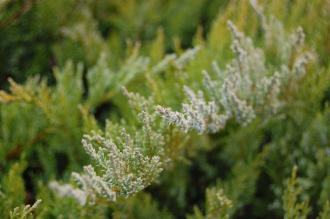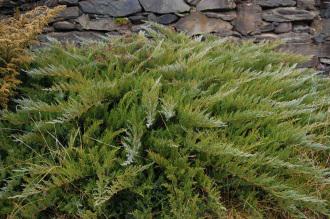
Juniperus sabina 'Buffalo' detail (26/12/2011, Belkovice, Czech Republic)
Position: Full sun
Flowering period: N/A
Soil: Well drained
Eventual Height: 0.5m
Eventual Spread: 2m
Hardiness: 3b – 7b
Family: Cupressaceae
Juniperus sabina ‘Buffalo’ is a low growing evergreen spreading shrub. The light green leaves are both needle like and scale like and when crushed produce the distinctive Juniper smell. The branches of this plant spread out from a central ‘trunk’, are relatively long, almost horizontal and turn up a the ends. The bark is reddish brown although difficult to see due to the dense foliage. The species, Juniperus sabina, is dioecious. This variety produces only a few berries, these are grey/ green in color and up to 5mm across and mature in about 18 months.
Juniperus sabina ‘Buffalo’ is commonly known as Buffalo Juniper. The species Juniperus sabina is native to central and souther Europe and central Asia. All parts of this plant are poisonous.
The etymological root of the binomial name Juniperus is derived from the old Latin name for the Juniper plant. Sabina is named after Joseph Sabine (1770-1837), a London based lawyer, naturalist and botanist, and a co-founder of the Linnean Society.

Juniperus sabina 'Buffalo' (26/12/2011, Belkovice, Czech Republic)
The landscape architect may find Juniperus sabina ‘Buffalo’ useful as an effective low maintenance, low growing evergreen ground cover plant, particularly when planted en mass. Once established this plant is drought tolerant and will tolerate hot locations. It will tolerate urban pollution.
J. sabina ‘Buffalo’ prefers well-drained soils. It is tolerant of most pH of soil. It will not tolerate water-logging.
J. sabina ‘Buffalo’ requires little maintenance. It may be tip pruned to control size.

